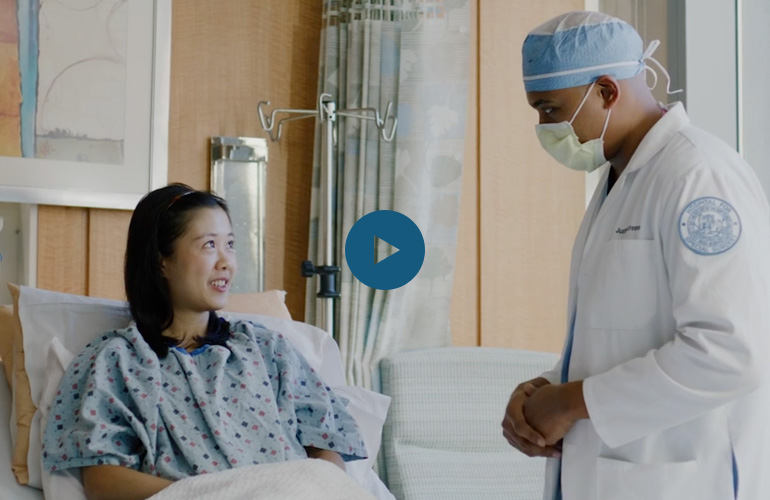Pain Management
Learn more about pain management
Inpatient post-operative pain management:
It is crucial to ensure patient comfort, promote faster recovery, and minimize complications associated with uncontrolled pain. Here are some common approaches and strategies for managing post-operative pain after spine surgery:
- Multimodal Analgesia:
- Utilize a combination of analgesic medications with different mechanisms of action to enhance pain relief.
- This may include opioids, non-steroidal anti-inflammatory drugs (NSAIDs), acetaminophen, muscle relaxants, and neuropathic pain medications.
- Patient-Controlled Analgesia (PCA):
- PCA pumps allow patients to self-administer a pre-set dose of pain medication, typically opioids, within specified time intervals.
- Provides patients with a sense of control over their pain management.
- Intravenous (IV) Medications:
- Administer analgesics intravenously, especially in the immediate post-operative period.
- Opioids such as morphine or hydromorphone are commonly used.
- Non-Pharmacological Approaches:
- Incorporate non-pharmacological methods like ice packs, heat therapy, and transcutaneous electrical nerve stimulation (TENS) to complement pain relief.
- Early Ambulation:
- Encourage early ambulation and mobilization, as movement can help prevent complications and improve recovery.
- Physical Therapy:
- Initiate physical therapy as soon as feasible to address muscle strength, flexibility, and overall functional recovery.
- Local Anesthetics:
- Use local anesthetics in surgical wound sites or around nerves to provide targeted pain relief.
- This can be achieved through local infiltration or nerve blocks intraoperative.
- Acetaminophen and NSAIDs:
- Use acetaminophen and NSAIDs cautiously to reduce reliance on opioids and manage inflammation.
- Antispasmodic Medications:
- Muscle relaxants may be prescribed to alleviate muscle spasms, which can contribute to post-operative pain.
- Regular Assessment:
- Implement a structured pain assessment protocol to monitor and address pain levels effectively.
- Adjust the pain management plan based on the patient’s response and needs.
We always individualize pain management plans based on the patient’s specific needs, the type of spine surgery performed, and any pre-existing medical conditions. Close collaboration between the surgical team, anesthesiologist, and pain management specialists is crucial for successful post-operative pain management.
Post-operative pain management for home:
Managing post-operative pain at home after spine surgery involves a combination of medications, self-care strategies, and communication with healthcare providers. Here are some general guidelines for post-operative pain management at home:
- Prescribed Medications:
- Take prescribed pain medications as directed by your healthcare provider.
- Follow the recommended schedule for pain medication to maintain a consistent level of pain control.
- If you experience side effects or inadequate pain relief, contact your healthcare provider before making any adjustments.
- Over-the-Counter Medications:
- Use over-the-counter medications such as acetaminophen or NSAIDs (if permitted) for additional pain relief.
- Always follow recommended dosages and guidelines, and be aware of any potential interactions with prescription medications.
- Ice and Heat Therapy:
- Apply ice packs or cold compresses to the surgical site during the initial days to reduce swelling.
- After the acute phase, switch to heat therapy (warm compresses) to help relax muscles and alleviate stiffness.
- Positioning and Support:
- Follow any specific positioning instructions provided by your surgeon or physical therapist.
- Use supportive pillows or cushions to maintain a comfortable position while sitting or lying down.
- Movement and Gentle Exercises:
- Gradually resume gentle movements and exercises as recommended by your healthcare provider.
- Avoid heavy lifting or strenuous activities until you receive clearance.
- Hydration and Nutrition:
- Stay well-hydrated, as dehydration can contribute to discomfort and slow the healing process.
- Maintain a balanced diet rich in nutrients to support healing and overall well-being.
- Rest and Sleep:
- Ensure you get adequate rest and sleep to promote healing.
- Use comfortable pillows and mattresses that support your spine and surgical site.
- Avoid Smoking and Limit Alcohol:
- Smoking can impair the healing process.
- Limit alcohol consumption, as it can interact with medications and affect recovery.
- Stay Connected with Healthcare Providers:
- Attend follow-up appointments as scheduled to assess your progress.
- Communicate any concerns, changes in pain levels, or unexpected symptoms promptly.
- Psychosocial Support:
- Seek emotional support from friends and family.
- Consider joining support groups or forums where you can connect with others who have undergone similar procedures.
- Follow Activity Restrictions:
- Adhere to any activity restrictions provided by your healthcare team.
- Gradually increase your activity levels based on your surgeon’s guidance.
Remember, individual experiences with pain and recovery can vary, so it’s important to communicate openly with your healthcare team. If you experience severe or worsening pain, signs of infection, or any unexpected symptoms, contact your healthcare provider promptly. They can provide guidance on adjusting your pain management plan or address any concerns related to your recovery.
At a Glance
Dr. Federico Girardi MD
- Triple fellowship-trained spinal surgeon
- Performs over 400 spinal surgeries per year
- Professor of orthopedic surgery at Cornell University
- Learn more



 / 965 Reviews
/ 965 Reviews